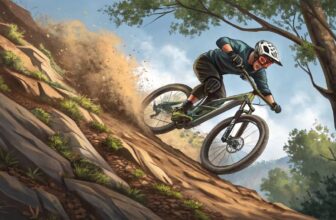Understanding Mountain Bike Brakes
Picking the right brakes can make your mountain biking ride smoother and safer. Let’s get into what makes these brakes tick and why they matter.
Introduction to Bike Brakes
Brakes on a mountain bike are more important than you might think; they keep you in control and stop you when things get hairy. There’s a variety of them, each bringing a little something special to the table. Let’s lay out the popular ones:
| Brake Type | Features | Where You’ll Find Them |
|---|---|---|
| V Brakes | Light, easy to fix, cheap | Starter and low-cost bikes |
| Disc Brakes | Strong stopping, wet-weather warrior | Mid to fancy bikes |
| Drum Brakes | Rarely broken, a cinch to fix | Electric and chill-paced bikes |
| Roller Brakes | Quick to stop, efficient | City and casual rides |
Figures courtesy of Best Wheel Set
Importance of Brake Systems
Why do brakes really matter? Here’s the scoop:
- Safety: Good brakes help you hit the brakes fast and reliably, keeping you from taking spills.
- Control: They give you control when the trails get tricky or you’re zooming downhill.
- Guts: With solid brakes, you feel braver to try new tricks and trails.
For example, disc brakes, especially hydraulics, are top dog in pro circles because they stop on a dime and last longer. On the flip side, V brakes are favored for their fuss-free nature, making them perfect for those on a budget.
So, as you fine-tune your ride, think about your brakes alongside other bits like the shock setup, tire pressure, and gears.
Stick around as we compare these brakes in the next section. For advice on keeping your brakes in tip-top shape, check out mountain bike maintenance.
Comparing Brake Types
Picking out the right brakes for your mountain bike can make all the difference when you hit the trails. Let’s break it down by looking at the main players: V brakes, disc brakes, drum brakes, and roller brakes.
V Brakes
V brakes are the go-to for many because they are light, cheap, and easy to tinker with. These nifty rim brakes clamp the wheel’s edge to slow your roll. With their long arm, you can really feel the stopping power, making them a solid pick for touring bikes, mixed-road hybrids, and even tandems.
| Feature | V Brakes |
|---|---|
| Weight | Light as a feather |
| Cost | Wallet-friendly |
| Maintenance | A cinch |
| Brake Efficiency | Packs a punch |
| Common Use | Tours, hybrids, tandems |
Disc Brakes
Disc brakes have clawed their way to the top of the world of high-flying mountain bikes. Divided into mechanical and hydraulic, these guys are mighty in their own right. Mechanical is the option for entry-level bikes, but hydraulic steals the show on the upscale models with its super slick moves and reliable stopping in any weather.
Disc brakes grab hold of a rotor on the wheel hub, halting your ride with power and grace.
| Feature | Mechanical Disc Brakes | Hydraulic Disc Brakes |
|---|---|---|
| Weight | Manageable | On the heftier side |
| Cost | Middle of the road | Pricey |
| Maintenance | So-so | Tricky |
| Brake Efficiency | Packs a wallop | Stopping superstar |
| Common Use | Entry-level bikes | Mid to high-end bikes |
Drum Brakes
Drum brakes, while not exactly a mountain bike staple, show up on city cruisers and e-bikes. They hardly ever fail and fixing them is a breeze, but they can get a bit hot under pressure. They use brake shoes pushing against a drum to get you to stop, kind of like a dance.
| Feature | Drum Brakes |
|---|---|
| Weight | Heavy duty |
| Cost | Fair |
| Maintenance | Easy-peasy |
| Brake Efficiency | Just okay |
| Common Use | City bikes, e-bikes |
Roller Brakes
Shimano’s roller brakes are the city cyclist’s favorite for their quick response and sensitivity. You see these more on urban wheels, with their weight being a bit much for the mountain game. Internally, they work their magic to bring the bike to a halt.
| Feature | Roller Brakes |
|---|---|
| Weight | Quite hefty |
| Cost | Steep |
| Maintenance | Manageable |
| Brake Efficiency | Pretty great |
| Common Use | City life, weekend rides |
Getting a handle on these brake choices helps you tailor to your biking style. For the deets on fine-tuning your brake setup, dig into brake fluid types, brake pad materials, and rotor design. Just itching for a little more head-to-head action? Check out the showdown on V Brakes vs. Disc Brakes and Mechanical vs. Hydraulic Disc Brakes.
V Brakes vs. Disc Brakes
Picking out the right brakes for your mountain bike can feel like choosing Harry Potter’s wand; it’s all about finding what suits you best. V brakes and disc brakes both have their quirks and perks, fitting different styles of riding like a glove.
Key Differences
How They Work:
- V Brakes: These are the trusty old pals, grabbing the rims with two calipers to stop the bike. Keeping your rims clean and smooth does wonders for these fellas.
- Disc Brakes: These work by grabbing onto a disc attached to your wheel hub. Think of them as the more sophisticated cousins—mechanical or hydraulic, they know how to handle the heat.
Bits and Pieces:
- V Brakes: Think simple, like peanut butter and jelly—with brake pads, calipers, and cables.
- Disc Brakes: A little more like a BLT with extra toppings: rotors, calipers, and your choice of mechanical cables or hydraulic fluid.
Build and Sturdiness:
- V Brakes: Light as a feather and simple as pie, though not so hot in the rain or mud.
- Disc Brakes: These beefier guys deliver in any weather, come rain or shine.
Pros and Cons
| Feature | V Brakes | Disc Brakes |
|---|---|---|
| Weight | Feather-light | Carrying a bit more mass |
| Cost | Easy on the wallet | Will make your wallet a little lighter |
| Maintenance | A breeze to keep running | A bit of a puzzle to fix |
| Wet Weather Performance | Slips a bit | Grip like a champ |
| Stopping Power | Good enough for a Sunday ride | Stops on a dime, even downhill |
| Wear and Tear | Relies on rim conditions | Frees your rims from the heavy lifting |
V Brakes: Love ‘Em or Leave ‘Em
Pros:
- Light enough you might think you forgot to install them.
- Wallet-friendly for those who like to keep an eye on spending.
- If you can replace a light bulb, you can manage these brakes.
- High brake efficiency thanks to their thoughtful design.
Cons:
- Not good friends with rain or muck.
- Needs those rims looking pristine.
- Lacks muscle compared to the discs.
Disc Brakes: The Showstoppers
Pros:
- Stopping comes naturally, especially when mountains are involved.
- They’ll have your back come sun or sleet.
- Rims take a breather; discs take the load.
- Control and coolness, they have both.
Cons:
- They hit the gym—you’ll feel the weight.
- More dough upfront, though.
- Mechanics might need a dictionary for these.
Making the right choice is a bit like picking toppings for your ice cream – it all boils down to what you like and what you need. Your budget, how often you want to fuss with maintenance, and your biking preferences will point you in the right direction. Need a little more help deciding? Check out our guides on budget considerations, riding style, and maintenance needs.
Mechanical vs. Hydraulic Disc Brakes
Mechanical Disc Brakes
Mechanical disc brakes work by using steel cables to transfer the force from the lever you squeeze to the calipers that grip the rotor. These things are like the trusty old pickup truck of the brake world—simple, reliable, and easy to fix. You don’t have to mess with that slippery hydraulic fluid, which makes maintaining these brakes a breeze. No need to deal with the mess and hassle of bleeding them, either, thank goodness.
But here’s the catch: those steel cables suffer from a bit of wear and tear due to the constant friction. It’s like they went on an all-you-can-eat buffet binge and then tried running a marathon. So, you might find yourself fiddling with them more often to keep things performing at their best. Lots of trail riders and DIY mechanics love them, though, for that very reason—they’re straightforward to tinker with when needed.
Hydraulic Disc Brakes
Hydraulic disc brakes? Now they are the performance sports car of the brake world. They use fluid to get the message from your hand to the bike wheels. This means better stopping power and finer control, which makes for buttery smooth stops. You’ll be pulling off stops with style and grace, stopping right on a dime. These brakes are the star quarterback, giving you solid power, consistency, and control on the track (Velotric Bike).
Here’s the rub, though: they’re a bit more high-maintenance. You’ve got to bleed them every now and then, get rid of air bubbles in that hydraulic fluid. It’s like giving them a regular doctor’s checkup, but a bit tricky—need some fancy tools and a sprinkle of expertise. Many serious riders and adrenaline junkies prefer hydraulic brakes despite this little hiccup, because nothing else compares when you’re chasing performance.
Performance and Maintenance Comparison
So, what’s it gonna be? Mechanical or hydraulic? Here’s a quick breakdown:
| Feature | Mechanical Disc Brakes | Hydraulic Disc Brakes |
|---|---|---|
| Maintenance | Easy peasy, no bleeding hassle | More hands-on, includes bleeding woes |
| Price Tag | Won’t burn a hole, pretty cheap | Costs a bit more, like 2-3 times more |
| Stopping Power | Just enough for the easy trails | Boss level for any terrain |
| Control (Modulation) | Basic, does the job | Real smooth operator |
| Durability | So-so, cables might wear down | Built strong, internals stay sharp |
For newcomers to mountain biking or those who like to get their hands dirty fixing things, mechanical disc brakes are as easy on the mind as on the wallet. Meanwhile, hydraulic brakes give you luxury and performance, appealing to intermediate adventurers wanting to boost their brake game, pros racing on the asphalt, or anyone who just wants the top-shelf stopping power.
When you’re deciding on the perfect brake setup for your mountain biking adventures, think about how you ride, if you like getting nifty with tune-ups, and, of course, what cash you’ve got to splash. Check out our articles on keeping your bike in shape with mountain bike maintenance and how to sort out hydraulic brakes.
Popular Mountain Bike Brake Models
When diving headfirst into mountain bike brake comparison, it’s handy to know what makes one brake model stand out from another. Here’s the lowdown on some top contenders in the biking brake world, giving you the inside scoop on what might suit your wheel-spinning adventures.
Shimano XT M8120
Meet the Shimano XT M8120, a favorite among mountain bike enthusiasts since 2019. Imagine having braking power at your fingertips ready to tackle any terrain. The hydraulic system ensures stopping power when you need it most. Heads up though – some riders have noticed it can start to feel a bit unpredictable after a bunch of rides in terms of its bite point, which means it’s worth keeping an eye on.
| Feature | Specification |
|---|---|
| Brake Type | Hydraulic Disc Brake |
| Adjustment | Tool-free reach adjustment |
| Weight | 410 grams |
| Key Highlight | Sharp power delivery |
SRAM Code RSC
If adjustability is your jam, then the SRAM Code RSC might just be a perfect match. On the scene since 2017, it’s been known for dialing in both reach and contact points like a pro. Even if newer models have slid into the spotlight, the Code RSC is still cruising along with its powerful stopping prowess – especially that contact point trick.
| Feature | Specification |
|---|---|
| Brake Type | Hydraulic Disc Brake |
| Adjustment | Reach and contact point |
| Weight | 430 grams |
| Key Highlight | Notably effective contact point adjuster |
Hope Tech 4 V4
Next up is the Hope Tech 4 V4, a brake that screams solid and sturdy. Building on the legacy of the Tech 3 V4, it’s got punchy power, smooth delivery, and a softer bite that some riders really dig. Plus, its thick lever blade gives it a different feel – it’s like gripping a trusty tool that means business.
| Feature | Specification |
|---|---|
| Brake Type | Hydraulic Disc Brake |
| Adjustment | Reach adjustment |
| Weight | 460 grams |
| Key Highlight | Linear power delivery |
Hayes Dominion A4
The Hayes Dominion A4, hitting the market in 2018, has sharp precision and power that make it a standout (Blister). With a soft stroke and quick power response, it flicks the switch from chill to charge in no time. Plus, their “Crosshair” alignment feature? It’s like having a friend to help align your caliper.
| Feature | Specification |
|---|---|
| Brake Type | Hydraulic Disc Brake |
| Adjustment | Tool-free reach adjustment |
| Weight | 450 grams |
| Key Highlight | Consistently firm bite point |
Picking the right mountain bike brake is about finding what makes your ride feel just right. For more tips on mountain bike maintenance and a bunch of other handy info, check out our related reads.
Factors Influencing Brake Performance
To pick out the best mountain bike brakes, you gotta know what makes ’em tick. Here, we get into what matters: brake fluid types, brake pad materials, and rotor design.
Brake Fluid Types
Hydraulic systems run on either mineral oil or DOT brake fluid. Here’s the scoop on each so you know what you’re getting into:
| Fluid Type | Boiling Point | Water Absorption | Maintenance/Replacement |
|---|---|---|---|
| Mineral Oil | ~190°C | No water absorption | Chill on the upkeep |
| DOT Brake Fluid (DOT 4, 5.1) | Hotter | Likes to drink up water (hygroscopic) | Needs frequent attention |
Mineral oil, coming from crude oil, clocks in with a boiling point of around 190°C. It doesn’t soak up water, so you don’t have to fuss over it as much, but a spill might spoil your brake pads. On the other side, DOT brake fluid, the more car-ready option, withstands higher temps and loves to soak up moisture, meaning you’ve gotta change it more often. But it performs like a champ when things heat up.
Brake Pad Materials
Brake pads are the unsung heroes, giving you that stopping muscle and lasting power. Let’s see what they’re made of:
| Pad Type | Material Composition | Durability | Rotor Wear | Noise | Braking Power |
|---|---|---|---|---|---|
| Metallic Pads | Metal goodies | Long-lasting | Eats rotors | Loud | Strong as heck |
| Organic Pads | Kevlar, carbon mix | Fair | Gentle on rotors | Whisper quiet | Decent stopping |
Metallic pads, loaded with metal oxides and carbides, give you great durability and stopping muscle but can be a bit screechy and hard on rotors. Organic pads, though, keep things quieter and kinder to rotors but might wear out a tad faster, offering milder stopping power. Want to soup them up? Check out aftermarket brake pads for a boost.
Rotor Design
Rotors are all about the braking finesse and keeping things cool:
| Rotor Type | Material | Heat Dissipation | Durability | Weight | Cost |
|---|---|---|---|---|---|
| One-Piece Rotor | Steel | Decent | Hardy | Average | Budget-friendly |
| Two-Piece Rotor | Steel/Aluminum lovefest | Tops | Rugged | Lighter | Pricer |
Rotors are mostly steel-built, with different thicknesses to handle the heat. One-piece rotors keep it simple and cheaper, whereas the swanky two-piece ones rock a floating design, sidestepping uneven heat expansion, letting you brake like a pro (Enduro Mountainbike Magazine). Plus, how they hook onto your bike—6-bolt versus Center Lock—plays into how long they’ll last and what they’ll fit with.
Grasping this knowledge means you’re ready to pick a brake system suited just for you. For more tidbits on gearing up your bike and keeping it slick, snoop around our guides on mountain bike maintenance and how to clean mountain bike.
Choosing the Right Brake System
Picking the right brakes for your mountain bike can make riding a ton more fun. It’s all about what you can afford, how you ride, and how much hassle you’re willing to put up with to keep everything working smoothly.
Budget Considerations
Money talks when you’re looking at bike brakes. Mechanical disc brakes are generally cheaper and easier on the wallet when it comes to keeping them working. But if you’re looking at hydraulic ones, prepare to fork over more cash for that fancy stopping power.
| Brake Type | Average Cost | Maintenance Cost |
|---|---|---|
| Mechanical Disc Brakes | $30-$50 | Low |
| Hydraulic Disc Brakes | $70-$150 | High |
- Stick with mechanical if you’re just starting out or on a budget.
- Go hydraulic if you’ve got the dough to spend and want top-notch performance.
Riding Style Adaptation
How you ride is a big deal for brake choices. Are you hitting the trails, cruising to work, or racing against the clock?
1. Trail Riding and Adventure Sports:
- Hydraulic disc brakes give you that extra edge on rocky paths and downhill thrills.
2. Commuting and General Use:
- Mechanical disc brakes get the job done for everyday rides and cushy roads.
3. Professional and Competitive Cycling:
- High-end hydraulic setups like the Shimano XT M8120 are a racer’s best friend.
Maintenance Requirements
Thinking about upkeep? It can be a breeze or a pain, depending on your brake choice. Hydraulics need more love and might have you visiting the pros more often.
| Brake Type | Maintenance Difficulty | Frequency of Maintenance |
|---|---|---|
| Mechanical Disc Brakes | Easy | Low |
| Hydraulic Disc Brakes | Moderate to High | Medium |
Mechanical Disc Brakes:
- Simple TLC
- Fewer visits to the bike shop
Hydraulic Disc Brakes:
- More complex, and might need expert attention
- Regular check-ups due to complexity
If you’re new to the biking scene or want hassle-free maintenance, mechanical disc brakes are your go-to. For those who live for precision and performance, hydraulic is the way to roll. To keep your bike in top shape, take a peek at our mountain bike maintenance article.
Thinking through these points will help you pick brakes that match your budget, style, and maintenance appetite. For more on what’s new with bike brakes, head over to our future-focused article on mountain bike brakes.
Future of Mountain Bike Brakes
Technological Advancements
The world of mountain bike brakes is buzzing with some exciting tech tweaks. Those hydraulic disc brakes that have taken over your favorite mountain trails? Oh, they’re not done improving yet. These bad boys already beat the pants off mechanical ones with their better control and power.
And now, tech nerds are pushing the envelope even more with wireless systems and extra snazzy cooling tricks that make your ride safer and smoother.
Industry Trends
Disc brakes have stomped their way into the biking scene, and they ain’t just for mountain bikes anymore. Road bikes are joining the disc brake bandwagon, replacing those old rim brakes especially on rough terrains and when cyclists are going full throttle in races. Every new cycling season seems to show off improved disc brakes, especially for adrenaline-inducing activities like cyclocross and mountain biking.
| Trend | What’s Happening |
|---|---|
| Hydraulic Disc Brakes | They’re calling the shots with better handling |
| Wireless Brakes | Coming soon to a bike near you with cooler control |
| Disc Brake Takeover | Even road bikes are catching on |
User Preferences
Rider vibes majorly sway the brake market. While hydraulic disc brakes keep winning contests for their awesome power, some cyclists, especially those not in the pro league, scratch their heads over whether they really need them in high-stakes scenarios. Then there’s the matter of cash-ola, as these top-notch brakes do tend to pinch the wallet a bit thanks to their fancy upkeep.
For those curious cats interested in learning more about bike tinkering and care, you might wanna check out our handy guides on mountain bike maintenance, diy mountain bike repairs, and mtb braking techniques.
By staying clued in on the latest gizmos, market moves, and what other riders are raving about, mountain bike lovers can keep rolling with the best brakes that match their biking style.




